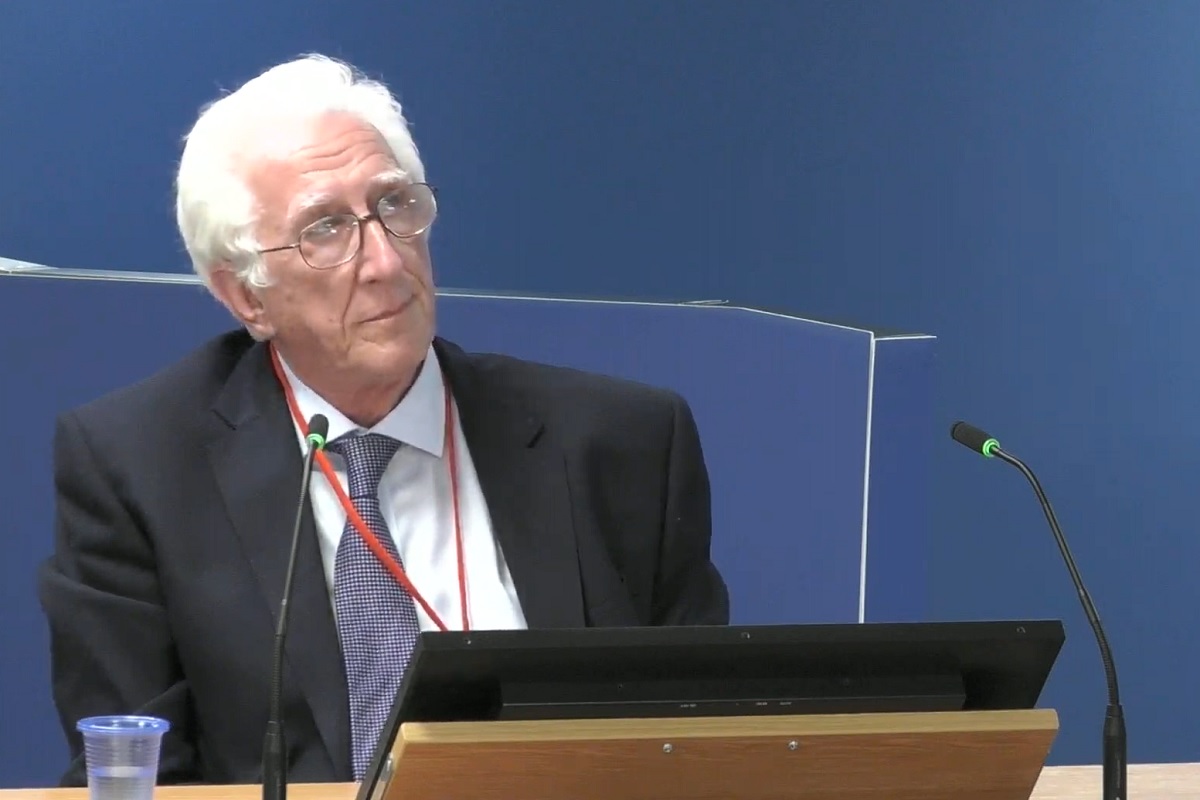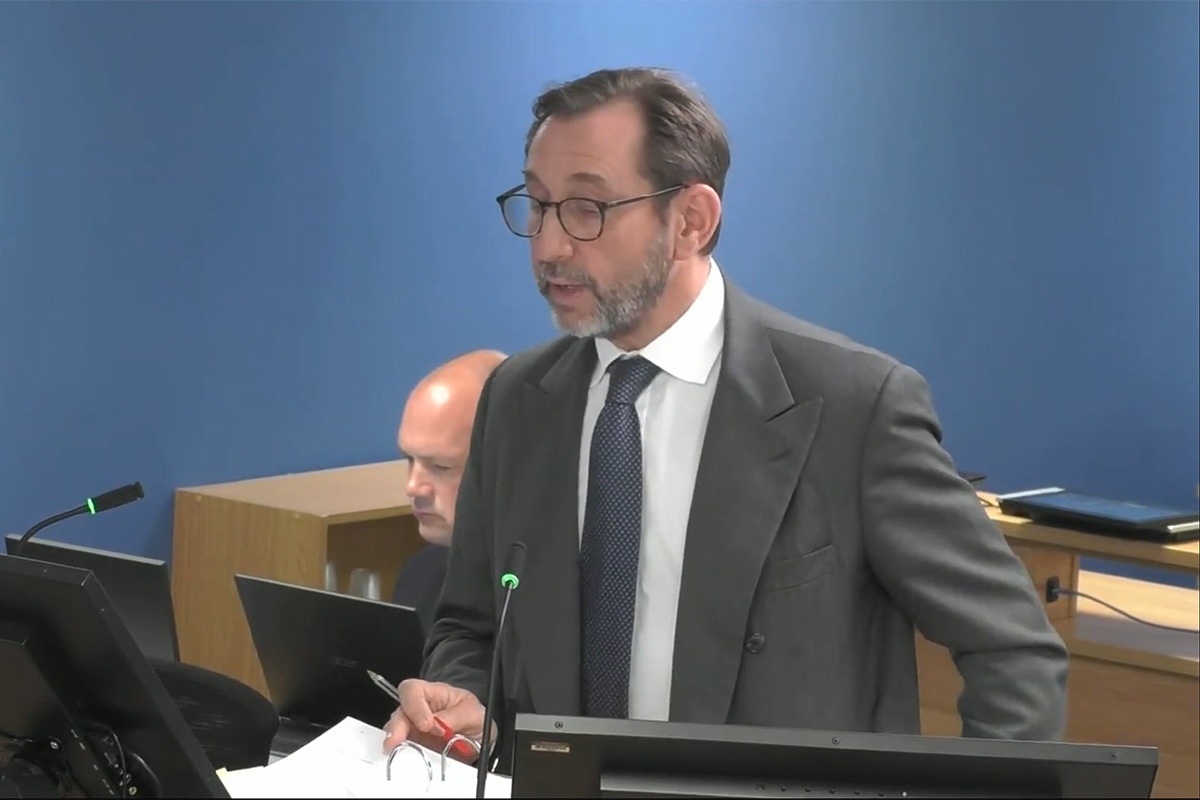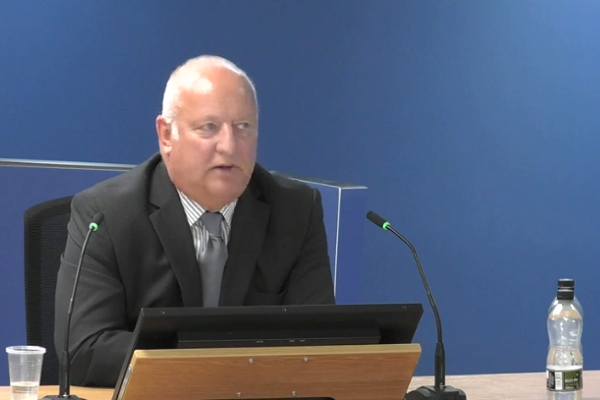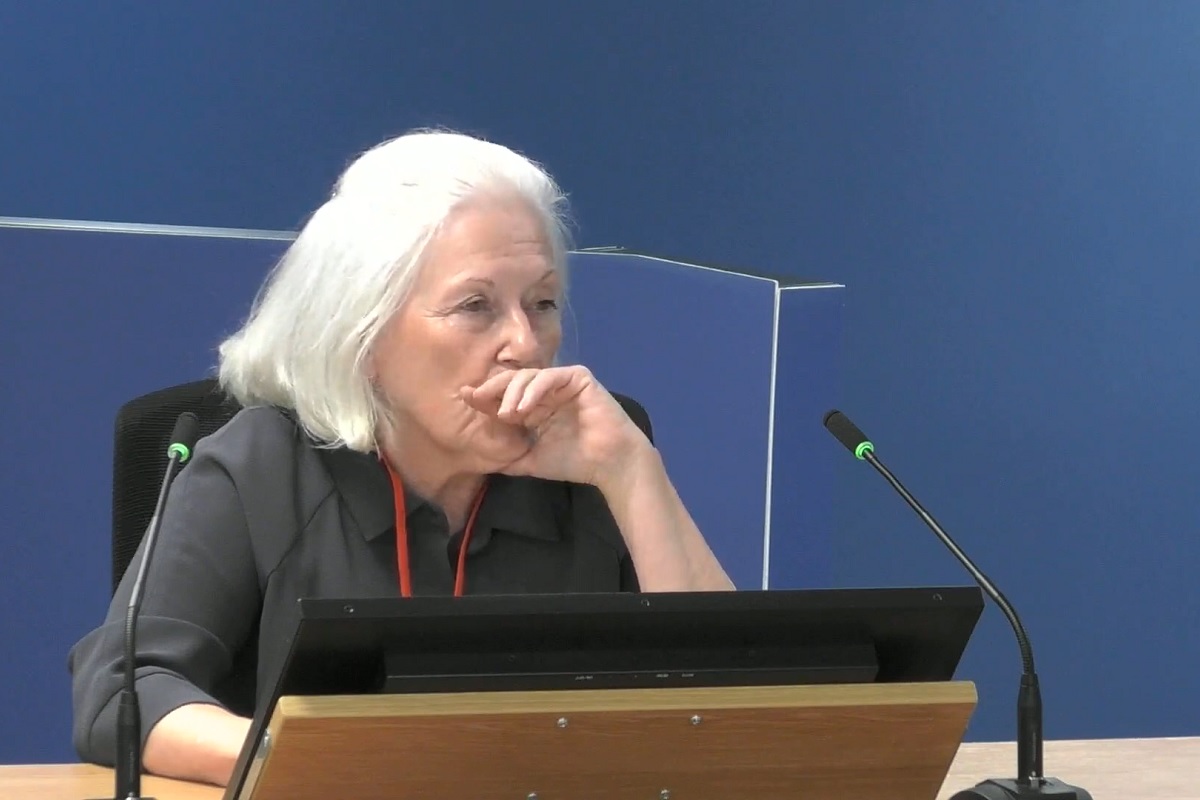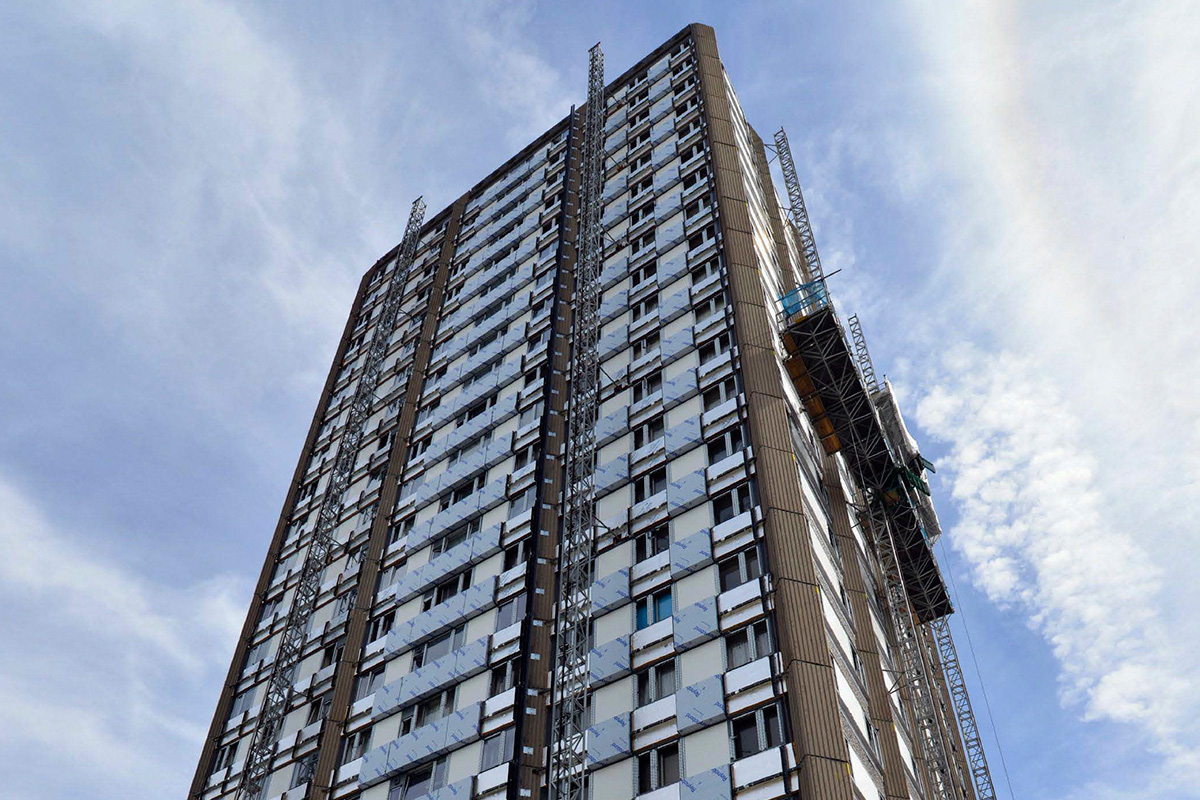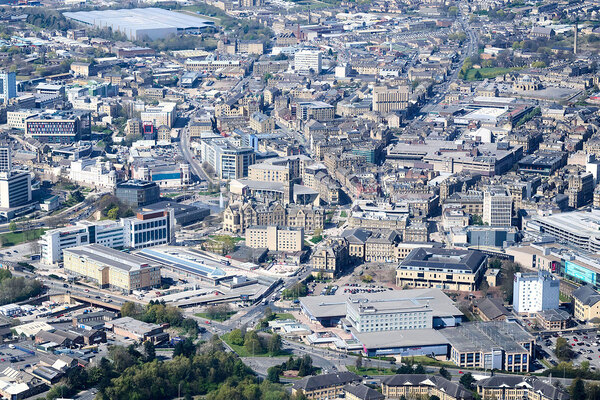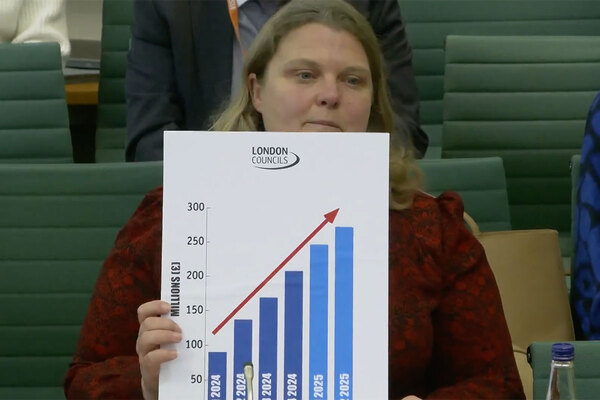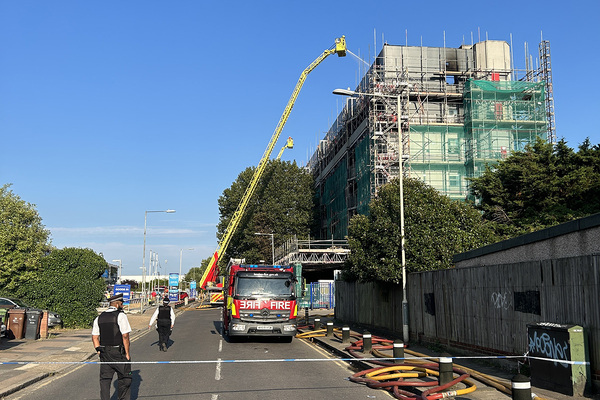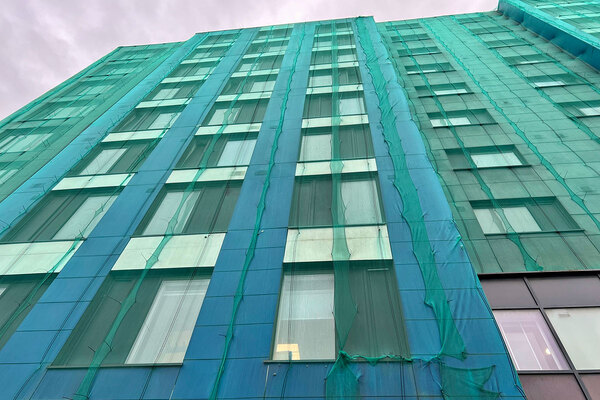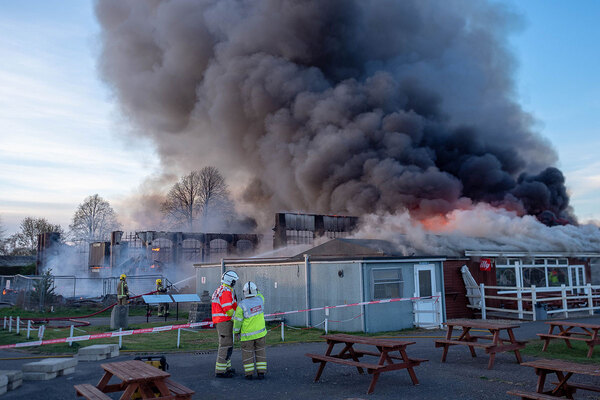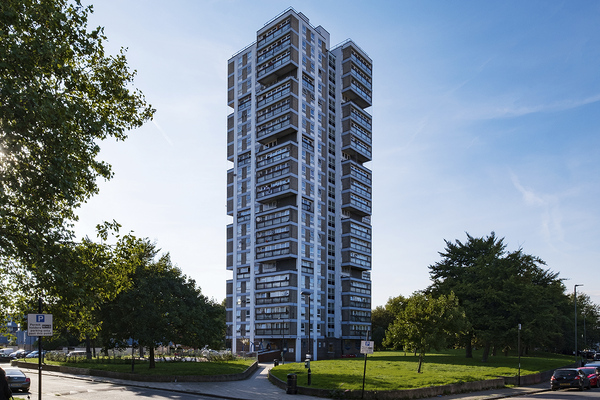Grenfell Tower Inquiry diary week 45: ‘Don’t you find all this rather a surprising debate, given that the Equality Act was passed in 2010?’
The inquiry heard from expert witness Colin Todd this week, who gave his views about the work of risk assessor Carl Stokes as well as answered questions about his own guidance. Peter Apps and Nathaniel Barker report
Colin Todd plays an interesting role at this inquiry.
Officially, his job is to act as an expert witness – an independent judge of what could reasonably have been expected of the tower’s fire risk assessor Carl Stokes.
But he is also an active player in the story, having led the work to write a key fire safety guidance – particularly a document aimed specifically at purpose-built blocks of flats in 2011.
So, his witness evidence mixed his independent view of the role of Mr Stokes with questions about whether his own guidance was sufficient.
We will start our recap with the issue of evacuation.
‘So does that tell us that people thought that stay put meant you didn’t have to think about evacuating disabled people?’
The inquiry has already heard that no personal emergency evacuation plans (PEEPs) were prepared for the many disabled residents in Grenfell Tower.
Many of them became trapped during the blaze. The inquiry has heard that 41% of the disabled residents present in the tower on the night of the fire died, a higher proportion than any other group.
Mr Todd is at the centre of a storm of controversy about this. His consultancy prepared guidance for the Local Government Association (LGA) in 2011 (endorsed by the government), which witnesses from Kensington and Chelsea Tenant Management Organisation (KCTMO) have said they followed in relation to the issue of PEEPs.
This guide advised managers of blocks of flats that it was “usually unrealistic” to write evacuation plans for residents with disabilities.
During his evidence, we heard that a very strong warning was issued in 2011, not long after the guide was published. A consultant wrote to the LGA to tell the organisation that the advice could result in “an unnecessary tragedy” and “reflects an outdated viewpoint which is highly discriminative and not in line with UK legislation”.
This letter was forwarded to government officials and Mr Todd for a response. They replied to say that it was not “reasonable and practical” to recommend evacuation plans for disabled people “by way of default in all blocks of flats”.
Mr Todd stood by these views when he gave evidence this week.
He was read passages from the relevant legislation – the Regulatory Reform (Fire Safety) Order 2005 – which requires that “in the event of danger, it must be possible for persons to evacuate the premises as quickly and as safely as possible”.
Asked if this implied a need to ensure escape was possible without the assistance of firefighters, Mr Todd said: “Other than for disabled people in blocks of flats.”
Mr Todd said this approach was justified because the legislation included the cavaet “where necessary” and in a general needs block with no staff it would not be “practicable” to arrange for evacuation of those with mobility issues.
He called the Grenfell Tower fire “a dreadful, dreadful, obscene anomaly”, but claimed disabled residents were generally most at risk from fire within their own flats – meaning evacuation was not the most important consideration in their safety.
“So does that tell us that people thought that stay put meant that you didn’t have to think about evacuating disabled people?” asked counsel to the inquiry Richard Millett QC.
“Some would take a different view from what I’m about to say, sir, but I would say that the majority view was exactly that,” replied Mr Todd.
This position was complicated by contradictory advice in another document – PAS 79 – for which Mr Todd was the “technical author”.
This guide, prepared for the British Standards Institution, offered a model methodology for risk assessors and was first published in 2005, with updates in 2007 and 2012. It did explicitly recommend that arrangements for evacuation of disabled occupants be considered.
When asked about the contradiction, Mr Todd said PAS 79 was written with commercial, not residential, buildings in mind. But nowhere in the guidance was this made clear.
“Is it right that the fire risk assessment trade regarded it as appropriate to take a different approach to disabled people in high-rise residential buildings from the approach they would take in an office block?” asked Mr Millett.
“That would have been the majority opinion, sir, yes, although people will, with the benefit of the lens of hindsight, argue about that now,” replied Mr Todd.
“Is there anything in the legislation or the guidance which would justify that majority opinion?” asked Mr Millett.
“I’m not sure that I can point to anything. It’s a matter of reasonable practicability, sir,” replied Mr Todd.
“Sitting there today, don’t you find all this rather a surprising debate, given that, for example, the Equality Act was passed in 2010?” asked Mr Millett.
Mr Todd said he did not find it “terribly surprising” because if the flats were built correctly, stay put can be “extremely favourable to disabled people”.
The Home Office has recommissioned Mr Todd’s consultancy to prepare new post-Grenfell guidance.
‘Was that persistent failure over those years consistent with your expectations of what a reasonably competent fire risk assessor should or would have done?’
So what of Mr Stokes’ work on this point? But he did consider the issue of disability in his risk assessments and gave it a specific section in all four assessments he carried out on the tower between 2012 and 2016.
Mr Todd recorded this as a “positive finding” in his report, noting that: “There is consideration of disabled people.”
But what Mr Stokes actually wrote in his assessments left something to be desired. In each report, he cut and pasted the same statement with only very minor alterations.
This said there was no evidence of any residents with an impairment which would prevent them hearing a shouted warning of fire.
He added that KCTMO was planning to gather further information and this would be used in the preparation of PEEPs if necessary. But he never, across four years, chased up this information from KCTMO.
“Was that persistent failure over those years consistent with your expectations of what a reasonably competent fire risk assessor should or would have done?” asked Mr Millett.
Mr Todd said he would have expected the risk assessor to ask about arrangements for disabled residents and for the building owner to “have some high-level generic information, but no greater detail than that”.
‘Did anybody ever ask themselves what the basis of excluding the external wall from the scope of the [assessment] actually was?’
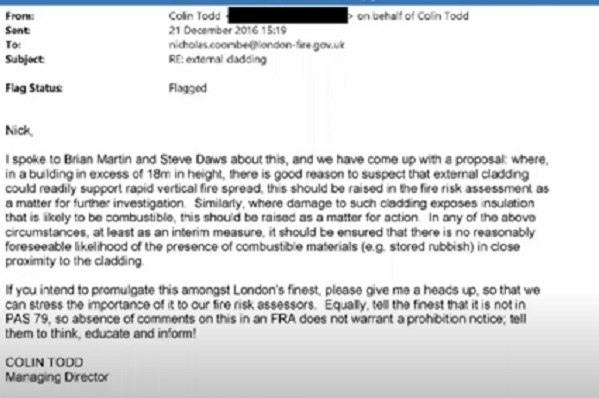
Mr Stokes’ risk assessments did not make any detailed assessment of the building’s external cladding system which, as we now know, turned out to be the primary cause of the rapid fire spread.
He did however write – in an assessment completed in 2016 as the refurbishment came to an end – that the materials used in the system were “fire-rated” and later told KCTMO when asked directly that the cladding complied with building regulations.
This was said despite his lack of knowledge of cladding, or any understanding of the type of materials used. But Mr Todd would not criticise the advice Mr Stokes gave on this point.
He said the cladding had “supposedly been installed under the watchful eye” of building control and “if they’d done their job properly as Mr Stokes assumed, then there wouldn’t have been a problem”.
“He’s absolutely gone far enough, sir, in my opinion,” Mr Todd insisted.
His belief was that consideration of the external wall was not required in a fire risk assessment. He said this view was held “very close to universally” in the profession.
But Mr Millett queried this, pointing out that while the legislation excluded domestic premises, there was nothing to say external walls should be excluded.
“What I’m getting from you is that people assumed… that the external wall was outside the scope of the [legislation] without really thinking about it?” said Mr Millett.
“That may be a little unfair to some colleagues in the profession, but I think it’s probably a reasonable assertion,” replied Mr Todd.
The inquiry was also shown an email from December 2016, when a senior member of the London Fire Brigade (LFB) asked Mr Todd if he had any guidance for assessors who did want to consider cladding – due to some concerns in the fire service about cladding.
Mr Todd responded, saying that he had spoken with Brian Martin, a senior civil servant within the Ministry of Housing, Communities and Local Government (MHCLG), and they “come up with a proposal” to require checks for buildings taller than 18 metres “where there is good reason to suspect that external cladding could readily support external fire spread”.
But such a change was not made before the fire.
The email – which had not previously been released – is the latest in a string of evidence that show warnings about cladding fires reached central government before the tragedy in June 2017.
Mr Martin will face extensive questioning when the inquiry turns to central government in the autumn. In his evidence, Mr Todd described Mr Martin as a “personal friend”.
‘I might not want to buy a second-hand car from him, but he might be perfectly competent at fixing the car’
Another major question in the inquiry has been whether Mr Stokes was an appropriate candidate to carry out risk assessments of KCTMO’s buildings and whether he presented his qualifications accurately.
Mr Stokes had worked for the fire service for two decades, which included a period of auditing risk assessments completed by others.
He then retired from the fire service, before completing a short training course and setting himself up as a risk assessor. Mr Todd delivered the training course.
Mr Todd’s view was that Mr Stokes’ qualifications were “suitable for the purpose of carrying out [risk assessments] for Grenfell Tower”.
It is important to emphasise here that there are no statutory competency requirements for fire risk assessors at all.
Mr Todd himself had drafted guidelines on what should be expected, but they were never made mandatory.
This, Mr Todd said, was a deliberate choice of government to reduce “burdens on business”.
“The government were very clear that to have required fire risk assessors to be competent, it would imply to the business community that they’d have to go out and buy in the services of a specialist,” he said. “And the Fire Safety Order was brought in in the name of reducing burdens on business.”
But what of how Mr Stokes presented his qualifications? The inquiry previously heard that he included a series of ‘post-nominals’ on his CV which related to qualifications he did not hold or did not exist.
Mr Stokes has said he did not know how post-nominals should be used and that he was simply trying to reflect training courses he had attended.
But Mr Todd was critical of this, saying his impression was that Mr Stokes was trying to “big himself up” and that this had the potential to mislead clients.
However, he said that there was “no need for him to do this” as his actual qualifications were perfectly adequate.
“I might not want to buy a second-hand car from him, but he might be perfectly competent at fixing the car, if I could use that analogy,” said Mr Todd.
‘Would you seriously describe as meticulous the work of a fire risk assessor who… pasted text into an [assessment] where it was completely inapposite?’
In general, Mr Todd called Mr Stokes’ work assessing the tower “quite meticulous”.
This was despite mistakes in his assessments which arose from cutting and pasting between documents.
For example, he said pigeon netting on balconies at Grenfell Tower did not present a risk. The tower had neither pigeon netting or balconies.
In his report, Mr Todd said this practice gave him only “slight concern”.
“Would you seriously describe as meticulous the work of a fire risk assessor who cut text from an [assessment] for building A and pasted that into an [assessment] for building B where it was completely inapposite?” asked Mr Millett.
“He went into incredible detail, but you would then have to sort out which of that detail was something of a cut and paste and which was specific and unique to the building,” said Mr Todd.
Mr Millett pressed him on this answer, pointing out that the failure indicated Mr Stokes “did not bother to read his own work before signing it off”. “Why is that something that only gives you slight concern? It’s quite a serious problem, isn’t it?” he asked.
Mr Todd accepted he may need to delete the word “slight”.
Lawyers acting for the bereaved have argued against Mr Todd’s evaluation of Mr Stokes’ work, with one saying aspects of his report “create the impression [he] is at pains to exonerate Stokes”.
Mr Todd did, however, criticise Mr Stokes’ work related to the smoke ventilation system at Grenfell Tower.
This crucial system which removes smoke from communal areas was known to be “beyond economic repair” for six years between 2010 and 2016.
Mr Stokes’ failed to raise concerns about the lack of information he was given regarding the operation and maintenance of the system
Mr Todd said that, as a result, Mr Stokes should have concluded the risk at Grenfell Tower to be “moderate” rather than “tolerable” and failing to do so “fell below acceptable standards”.
‘Are you aware of this reoccurring fault?’
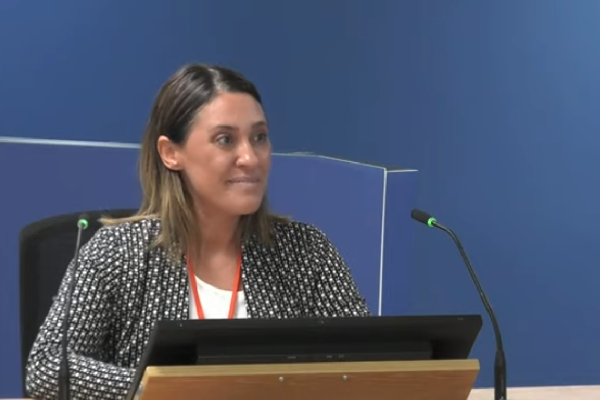
Earlier in the week, the inquiry heard from Abigail Acosta, a project manager who oversaw the replacement of fire doors in blocks of flats across KCTMO’s stock in the early 2010s.
This programme is significant because the doors fitted were not up to standard. They did not have the requisite smoke leakage certification, did not meet the 30-minute fire-resistance standard they were advertised as possessing and had a critical flaw with the self-closing device.
The doors were procured via the London Housing Consortium (LHC) procurement network, a list of approved contractors and suppliers for social landlords in London. They were Manse Masterdor products, which are widely used in the sector.
Ms Acosta accepted that KCTMO received no actual fire-testing information when it purchased the doors, just a brochure and a series of product certificates from Masterdor.
“Do you accept that, absent those fire test certificates, the TMO could not be certain that the doors had been tested to the relevant regulatory standards?” asked counsel to the inquiry Andrew Kinnier QC.
“Yes,” replied Ms Acosta.
A sample of the doors were inspected on installation by a representative of the LHC, who reported that the “door supplied was of a good quality and professionally installed”.
But these checks only viewed just over 10% of the doors installed. “At the time, were you satisfied that inspecting 137 out of nearly 1,200 was acceptable for your purposes?” asked Mr Kinnier.
“Yes, at the time, yes,” replied Ms Acosta.
A major issue that the inquiry has uncovered is faulty self-closers. Evidence from Grenfell Tower residents and a former caretaker suggested that the closing device was prone to jamming or falling out.
This was believed to be due to the use of screws which were too small and, in some instances, broken closers on the new doors were disconnected by KCTMO staff and not replaced.
There were a large number of missing or defective self-closers in Grenfell Tower, which is believed to have been a major contributing factor to the rapid spread of smoke through communal areas on the night of the fire.
The inquiry saw an email from Mr Stokes to Ms Acosta in July 2011 which read: “On Tuesday I was at Lancaster West [the estate where Grenfell Tower is located] and was informed that the self-closing device on three of the new flat entrance doors have come away from the door, this is the same problem as in King Charles House [another block]. Are you aware of this reoccurring fault?”
Ms Acosta said she raised this with Manse Masterdor, which did replace the screws on some doors, but only those where a fault had been identified, not throughout the stock.
‘I’m very confused as to what was actually thought to be required’
The week’s proceedings were rounded off with three-and-a-half hours of evidence from expert witness Beryl Menzies, an experienced building engineer specialising in fire safety.
Ms Menzies was principally asked technical questions about a report she produced for the inquiry which scrutinised the work of Royal Borough of Kensington and Chelsea’s (RBKC) building control department regarding the smoke control system installed in the tower.
Remember that RBKC had previously admitted multiple failings by building control in signing off the refurbishment.
The smoke control system at Grenfell Towe was altered using a bespoke design during the refurbishment, having been in a sorry state before that point.
The inquiry heard that it leaked smoke onto multiple floors on the night of the fire.
It did not comply with building regulations, but those involved in its design have argued that would have been impossible given the nature of the building so they tried to do the best they could.
The aim was to achieve a performance of smoke being sucked out of lobbies at two metres per second and this is what was promised to building control.
Ms Menzies felt that this performance-based design for the system “was acceptable in principle”. However, she concluded that building control ended up wrongly accepting the system’s compliance based only on a rather basic check carried out by a third party in April 2016.
She could find no evidence that building control officers ever “confirmed or witnessed the physical path of the air (smoke) movements away from the stair and that there was no significant inflow from other leakage paths such as the fire flat”.
That failure, she told the inquiry, fell below the standard of a reasonably competent building control body.
The Grenfell Tower Inquiry will now break for five weeks and will resume with the evidence from expert Dr Barbara Lane, the final witness for this phase, in September.
Grenfell Tower Inquiry headlines: week 45
Warning government-endorsed fire safety guide could lead to tragedy issued in 2011
The Local Government Association was warned a decade ago that fire safety guidance it had published could lead to an “unnecessary tragedy” because of its failure to recommend evacuation plans for disabled residents, the Grenfell Tower Inquiry heard.
Legal obligations to make provision for safe evacuation of residents were understood by the industry not to apply to disabled people in blocks of flats, an expert witness has told the Grenfell Tower Inquiry.
Government set no standards for competence of risk assessors to reduce ‘burdens on business’
The government declined to set standards for the competence of fire risk assessors because of its focus on “deregulation” and reducing “burdens on business”, an expert witness has told the Grenfell Tower Inquiry.
Grenfell Tower Inquiry phase two: weekly diaries
Module one: the refurbishment
Week one: A vivid picture of a broken industry
After a week of damning revelations at the opening of phase two of the Grenfell Tower Inquiry, Peter Apps recaps the key points
Click here to read the full story
Week two: What is the significance of the immunity application?
Sir Martin Moore-Bick has written to the attorney general requesting protection for those set to give evidence at the Grenfell Tower Inquiry. Peter Apps explains what the move means
Click here to read the full story
Week three: Architects of misfortune
This week saw the lead architects for the Grenfell Tower refurbishment give evidence to the inquiry. Peter Apps runs through the key points
Click here to read the full story
Week four: ‘I didn’t have any perception that it was the monster it’s become’
The architects continued to give evidence this week, outlining a lack of understanding of the fire risk posed by the cladding materials and its design. Nathaniel Barker reports
Click here to read the full story
Week five: ‘No adverse effect in relation to external fire spread’
As the Grenfell Tower Inquiry returns from its long absence, Peter Apps recaps the key points from a week of important evidence from the fire consultants to the refurbishment
Click here to read the full story
Week six: ‘I can’t recall any instance where I discussed the materials with building control’
Nathaniel Barker summarises what we learned from fire engineers Exova, architects Studio E and the early evidence from contractor Rydon
Click here to read the full story
Week seven: ‘I do not think I have ever worked with a contractor operating with this level of nonchalance’
Two key witnesses from contractor Rydon gave evidence this week. Peter Apps recaps some of the key points from a revealing week of evidence
Click here to read the full story
Week eight: ‘It haunts me that it wasn't challenged’
Four witnesses from contractor Rydon gave evidence this week. Lucie Heath recaps what we learned on the last week of evidence before the inquiry breaks for five weeks
Click here to read the full story
Week nine: ‘All I can say is you will be taken out for a very nice meal very soon’
This week the inquiry heard evidence from witnesses at Harley Facades, the sub-contractor responsible for Grenfell Tower’s cladding. Peter Apps recaps the key points
Click here to read the full story
Week 10: ‘As we all know, ACM will be gone rather quickly in a fire!’
As the Grenfell Tower Inquiry entered its 10th week, Jack Simpson recaps the key points from a week of important evidence from the refurbishment’s cladding contractor
Click here to read the full story
Week 11: ‘Did you get the impression Grenfell Tower was a guinea pig for this insulation?’
With witnesses from the cladding subcontractor, the firm which cut the deadly panels to shape and the clerk of works which inspected the job giving evidence this was week full of revelations. Peter Apps recaps the key points
Click here to read the full story
Week 12: ‘Would you accept that was a serious failing on your part?’
With the surveyor who inspected Grenfell Tower for compliance giving evidence, this was a crucial week from the inquiry. Dominic Brady and Peter Apps report
Click here to read the full story
Week 13: ‘Value for money is to be regarded as the key driver for this project’
With consultants to Kensington & Chelsea Tenant Management Organisation (KCTMO) giving evidence, attention at the Grenfell Tower Inquiry turned for this first time to the actions of the TMO and the council. Peter Apps reports
Click here to read the full story
Week 14: ‘Did it not occur to you at this point that your budget was simply too low?’
This week, for the first time in phase two, the inquiry heard from Kensington & Chelsea Tenant Management Organisation, the landlord that oversaw the fatal refurbishment of Grenfell Tower. Lucie Heath reports
Click here to read the full story
Week 15: ‘Have you ever informed the police that you destroyed documents relevant to their investigation?’
Witnesses from the Kensington and Chelsea Tenant Management Organisation (KCTMO) gave evidence for a second week, which began with a shocking revelation about withheld and destroyed evidence. Peter Apps recaps
Click here to read the full story
Week 16: ‘I conclude this was very serious evidence of professional negligence’
This week saw members of Kensington & Chelsea Tenant Management Organisation finish giving evidence, before the inquiry’s expert witnesses took the stand to make some highly critical assessments of the work they had seen before and during the refurbishment of Grenfell Tower. Jack Simpson recaps
Click here to read the full story
Grenfell Tower: a timeline of the refurbishment
Following the conclusion of module one of the Grenfell Inquiry’s second phase, Peter Apps presents a timeline of the key moments during the fatal refurbishment of the west London tower block
Click here to read the full story
Module two: the cladding products
Week 17: ‘It’s hard to make a note about this because we are not clean’
The start of the second module of the Grenfell Tower Inquiry phase two came with some huge revelations about the companies that sold the products used in the cladding system. Peter Apps reports
Click here to read the full story
Week 18: ‘It was just reckless optimism wasn't it?’
As the inquiry began cross-examining witnesses for the second module of its phase two work, the picture surrounding just how Grenfell Tower ended up wrapped in such dangerous materials became a little clearer. Nathaniel Barker was keeping an eye on proceedings
Click here to read the full story
Week 19: ‘And that was intentional, deliberate, dishonest?’
The Grenfell Tower Inquiry this week heard the shocking story of how the insulation manufacturer “manipulated” official testing and marketed its product “dishonestly”. Peter Apps tells the story
Click here to read the full story
Week 20: ‘We were outed by a consultant who we then had to fabricate a story to’
This week the inquiry investigated the actions of Kingspan – the manufacturer of one of the insulation products used in the tower’s cladding system. Dominic Brady reports
Click here to read the full story
Week 21: ‘It’s there in black and white isn't it? We see a complete absence of any consideration of life safety’
The story of insulation giant Kingspan’s testing and marketing of its combustible insulation for high rises was unpacked in minute detail this week. Peter Apps reports
Click here to read the full story
Week 22: ‘All we do is lie in here’
In the third week of evidence from insulation giant Kingspan, the inquiry continued to uncover shocking details about the firm’s behaviour both before and after the Grenfell Tower fire. Lucie Heath reports
Click here to read the full story
Week 23: ‘That would have come as an earthquake to you at the time, would it not?’
This week the inquiry took its deepest dive yet into the inner workings of the cladding manufacturer whose product has been blamed for the terrible spread of fire up Grenfell Tower. Nathaniel Barker reports
Click here to read the full story
Week 24: ‘Do you accept that Test 5B was Arconic's deadly secret’
The president of the firm that made and sold the cladding panels installed on Grenfell Tower was asked to account for the apparent concealment of “disastrous” fire tests on the product this week. Peter Apps reports
Click here to read the full story
Week 25: ‘This is quite an incredible list of omissions and missed instances, isn’t it?’
This week the Grenfell Tower Inquiry heard its first witnesses from the Building Research Establishment (BRE) - the testing house which carried out key fire tests on the Kingspan and Celotex insulation products which were later used on Grenfell Tower. Peter Apps reports.
Click here to read the full story
Week 26: 'You were taking an enormous risk, weren't you?'
Week 26 at the Grenfell Tower Inquiry was a key moment in understanding how dangerous products used on the tower came to be accepted by industry professionals. Dominic Brady reports
Click here to read the full story
Week 27: ‘What will happen if one building made out [of] PE core is in fire and will kill 60 to 70 persons?’
The most explosive evidence this week at the Grenfell Tower Inquiry came from those who did not attend, as the evidence which would have been presented to Arconic witnesses was displayed in their absence. Peter Apps reports
Click here to read the full story
Week 28: ‘This is a serious safety matter’
This week the Grenfell Tower Inquiry zeroed in on the British Board of Agrément, the body that produced “misleading” certificates which inspired trust in both the cladding and insulation used on the tower. Lucie Heath reports
Click here to read the full story
Week 29: ‘Is it true that Kingspan’s position… was to do its best to ensure that science was secretly perverted for financial gain?’
The final week in this section of the Grenfell Tower Inquiry primarily examined the attempts by insulation manufacturer Kingspan to lobby government after the fire. Peter Apps reports
Click here to read the full story
How the products used in Grenfell Tower's cladding system were tested and sold
As the section of the Grenfell Tower Inquiry examining how the products used in the cladding system were tested, marketed and sold comes to a close, Peter Apps summarises what we have learned about each of the products included in the system
Click here to read the full story
Module Three: the management of the tower
Week 30: ‘There is certainly a high probability that in the event of a fire the whole building can become an inferno’
The focus of the inquiry shifted this week to the actions of the social housing providers responsible for maintaining Grenfell Tower. Pete Apps recaps what we learned
Click here to read the full story
Week 31: ‘If we cannot get out people will die’
This week saw the former residents of Grenfell Tower enter the witness box to tell of their experiences attempting to raise complaints with the council and its managing agent. Pete Apps reports
Click here to read the full story
Week 32: ‘Let's hope our luck holds and there isn't a fire’
This week saw the return of the landlord of Grenfell Tower, Kensington and Chelsea Tenant Management Organisation (KCTMO), as senior staff members attempted to explain how vital fire safety protections at the block were allowed to fall into disrepair. Lucie Heath reports
Click here to read the full story
Week 33: ‘Isn't that a serious gap in the scope of a policy meant to safeguard vulnerable people?’
A slightly disjointed week at the Grenfell Tower inquiry saw further evidence from staff at building manager Kensington and Chelsea Tenant Management Organisation (KCTMO) interspersed with the views of a cladding expert. Peter Apps reports
Click here to read the full story
Week 34: ‘Some members of the community are doing their best to spread false information’
Jack Simpson covers all the major revelations from the past week of evidence at the Grenfell Inquiry, including evidence from Laura Johnson, director of housing at the Royal Borough of Kensington and Chelsea.
Click here to read the full story
Week 35: ‘I really didn’t like the champagne’
This week the Grenfell Tower Inquiry saw council witnesses, including former deputy leader Rock Feilding-Mellen and leader Nicholas Paget-Brown, questioned about their role in the story for the first time. Peter Apps reports
Click here to read the full story
Week 36: ‘Is that not a very incurious approach for a fire risk assessor?’
This week the Grenfell Tower Inquiry scrutinised the work of Carl Stokes, the man hired to carry out fire risk assessments for the block. Nathaniel Barker reports
Click here to read the full story
Week 37: ‘In giving that advice, weren’t you acting beyond your knowledge and expertise?’
A curtailed week at the Grenfell Tower Inquiry saw fire risk assessor Carl Stokes grilled over advice he gave regarding the tower’s cladding. Peter Apps reports
Click here to read the full story
Week 38: ‘Well it’s a bit more than that, isn’t it. He’s suggesting that you tell the LFB a lie’
The inquiry heard the mammoth cross-examination of KCTMO’s health and safety manager Janice Wray this week. Peter Apps reports
Click here to read the full story
Week 39: ‘What you said there was a grotesque understatement’
This week the inquiry continued to hear from former employees of Kensington and Chelsea Tenant Management Organisation, as well as two employees from the London Fire Brigade. Lucie Heath reports
Click here to read the full story
Week 40: ‘An exercise in concealment and half-truth’
Former KCTMO chief executive Robert Black gave his evidence to the inquiry this week and was asked to account for the various failures described over the previous six weeks. Peter Apps and Nathaniel Barker report.
Click here to read the full story
Week 41: ‘We should do nothing. This is not the sort of website we should be responding to’
This week saw the return of Robert Black, chief executive of Kensington and Chelsea Tenant Management Organisation (KCTMO), before the inquiry turned its attention to the defective smoke control system in the tower. Dominic Brady reports
Click here to read the full story
Week 42:‘They would leak as much as they leaked. They were what they were’
The Grenfell Tower Inquiry continued its in-depth investigation of the tower’s non-compliant smoke control system this week, with evidence from the various contractors involved in delivering it. Pete Apps reports
Click here to read the full story
Week 43:‘Contractors at the time were not generally aware of the importance of leaving holes unsealed’
This week the inquiry focused on two of the more overlooked areas of the Grenfell Tower fire, with evidence focusing on the gas pipelines and lifts within the west London block. It was a packed week, with five witnesses giving evidence. Jack Simpson reports
Click here to read the full story
Week 44:‘I've never seen a fully compliant firefighting lift in any local authority building, to this day actually’
This week the inquiry turn the focus onto the building’s defective lifts, with evidence from an expert, contractors who worked on them and a former engineer at KCTMO. Pete Apps reports.
Click here to read the full story
Week 45: ‘Don’t you find all this rather a surprising debate, given that the Equality Act was passed in 2010?’
The inquiry heard from expert witness Colin Todd this week, who gave his views about the work of risk assessor Carl Stokes as well as answered questions about his own guidance. Peter Apps and Nathaniel Barker report
Click here to read the full story
Week 46: ‘I think I've been very, very clear that is completely wrong’
This week the inquiry heard further expert evidence about fire risk assessor Carl Stokes’ actions, as the section of its work covering the management and maintenance of the tower concluded. Peter Apps reports
Click here to read the full story
Six key failures in the way Grenfell Tower was managed before the fire
Peter Apps recaps some of what we have learned about the actions of the Royal Borough of Kensington and Chelsea (RBKC) and Kensington and Chelsea Tenant Management Organisation (KCTMO) in the years before the fire.
Module one and two closing statements
Week 47: ‘An unedifying spectacle’
After a week of closing statements from the core participants involved in modules one and two, Lucie Heath recaps the key arguments of each group
Click here to read the full story
Module five: the fire brigade
Week 48: ‘They knew, and lives could and should have been saved’
The phase of the Grenfell Tower Inquiry examining the actions of the London Fire Brigade in the years before the fire kicked off this week with some major revelations. Peter Apps reports
Click here to read the full story
Week 49: ‘I'm not sure we've always taken every opportunity to learn as an organisation’
How the London Fire Brigade acted upon lessons from incidents in the years before the Grenfell Tower disaster came under the microscope this week at the public inquiry. Nathaniel Barker reports
Click here to read the full story
Week 50: ‘There is a culture in LFB that is very conservative. I think there is great comfort in what is familiar’
This week the inquiry heard how the London Fire Brigade (LFB) elected not to issue warnings about dangerous cladding before Grenfell and a detailed examination of its policy for checking high risk buildings. Pete Apps reports.
Click here to read the full story
Week 51:‘We teach firefighters to expect building failure’
An unusually brief week of evidence at the Grenfell Tower Inquiry explored how a fire service neighbouring London was taking a different approach to tackling blazes in high rises. Nathaniel Barker reports
Click here to read the full story
Week 52: ‘I actually think that there is a measure of incompetence at all levels’
Expert evidence concluded the current section of the inquiry with some stinging criticism of the London Fire Brigade (LFB). Pete Apps and Grainne Cuffe report.
Click here to read the full story
Module six: fire services
Week 53: ‘They make for chilling reading and harrowing listening’
The inquiry’s investigation into central government began this week with lawyers setting out their view on how and why firefighting policies failed. Peter Apps and Lucie Heath report
Click here to read the full story
Week 54: ‘Our consideration of evacuation at this time was something of a blind spot’
The development of policy on ‘stay put’, both nationally and for London, occupied the attention of the inquiry this week. Peter Apps reports
Click here to read the full story
Week 55: ‘My review is pretty scathing!’
In a week that included the 200th day of evidence in phase two of the inquiry, attention turned to the London Fire Brigade’s control room. Lucie Heath reports
Click here to read the full story
Week 56: ‘Why didn't we thump the table harder’
This week, the control room at the London Fire Brigade was examined further – both before and after the fire. Pete Apps and Lucie Heath report
Click here to read the full story
Week 57: ‘It was worse than slow, it was sluggish’
Former London Fire Brigade (LFB) commissioner Dany Cotton was the star witness this week, as the inquiry continued to delve into the brigade’s knowledge and training before the Grenfell Tower fire. Jack Simpson, Grainne Cuffe and Pete Apps report
Click here to read the full story
Week 58: ‘I don't think we deserve to ask for trust until we demonstrate different outcomes’
A current and former commissioner of the London Fire Brigade (LFB) wrapped up the inquiry’s investigation into the actions of the brigade before the fire. Grainne Cuffe and Peter Apps report.
Module six: testing and government
One of the major scandals of our time: key revelations as the Grenfell Tower Inquiry turns to government
The government was accused of “covering up” the risks of dangerous cladding as its “unbridled passion for deregulation” left it a “junior party” to the construction industry as the latest phase of the public inquiry opened today. Peter Apps summarises some of the main points
Click here to read the full story
Week 59: ‘Recent tests have apparently shown it continued to burn for 20 minutes after the flame was taken away’
After shocking opening statements, the Grenfell Tower Inquiry turned its attention to the work of Local Authority Building Control. Pete Apps reports
Click here to read the full story
Week 60: ‘You could have an exact repeat of the Dubai fire in any number of buildings in London’
The Grenfell Tower Inquiry turned its attention to the work of the National House Building Council this week, with shocking revelations about the extent of the warnings issued to central government before the fire. Peter Apps reports
Click here to read the full story
Week 61: ‘Mistakes are meant for learning, not repeating’
In the first hearings of the new year, the Grenfell Tower Inquiry heard closing statements from the firefighting section of phase two. Lucie Heath reports
Click here to read the full story
Week 62: Did it ever occur to you that this act of collaboration was, in one sense, corrupting?
The Grenfell Tower Inquiry returned to the work of the National House Building Council (NHBC) this week, with a new shocking revelation about the government’s actions in the immediate aftermath of the fire. Peter Apps reports
Click here to read the full story
Week 63: ‘It came after the general move to deregulation. So more regulation was not welcome’
The government’s focus on deregulation before the Grenfell Tower fire was placed in the spotlight this week with a series of shocking revelations about its failure to amend fire safety guidance. Pete Apps and Grainne Cuffe report
Click here to read the full story
Week 64: ‘I didn’t think ACM would be suitable for use in any high-rise buildings. I don’t think anyone did’
This week, the Building Research Establishment’s Dr Sarah Colwell gave more than three days of evidence, with some huge revelations about what was known about the dangers of aluminium composite material years before the fire and the mass confusion over the government’s building regulations. Peter Apps and Jack Simpson report
Click here to read the full story
Week 65: ‘Unless the government does something now about ACM panels, people will die’
Further evidence from the Building Research Establishment and the first government witnesses added new depth to our understanding of how warnings were missed before the Grenfell Tower fire. Peter Apps reports
Click here to read the full story
Week 66: ‘Was there a cover-up?’
The latest evidence from the Grenfell Tower Inquiry tracked the government’s failure to act on fire safety warnings right up until the months before the fire. Peter Apps and Grainne Cuffe report
Click here to read the full story
Week 67: ‘When exposed to a fire, the aluminium melts away and exposes the polyethylene. Whoosh!’
This week the inquiry heard disturbing new evidence about the failure of senior government officials to act on warnings about dangerous cladding in the years before the Grenfell Tower fire. Peter Apps reports
Click here to read the full story
Week 68: ‘Can we agree that was a pretty dangerous thing to have, all this falling on one man’s shoulders?’
Three senior civil servants gave evidence this week, including the official who had responsibility for building regulations guidance on fire safety in the years before Grenfell. Peter Apps, Lucie Heath, Stephen Delahunty and Grainne Cuffe report
Click here to read the full story
Week 69: ‘It was just unthinkable. You had the makings here of a crisis you could not comprehend’
This week, civil servant Brian Martin gave his long-awaited evidence to the Grenfell Tower Inquiry. Peter Apps reports
Click here to read the full story
Week 70: ‘Show me the bodies’
An important week at the Grenfell Tower Inquiry saw a dramatic conclusion to the mammoth cross-examination of civil servant Brian Martin, as well as the first politicians. Peter Apps and Lucie Heath report
Click here to read the full story
Week 71: ‘I have changed my schedule to fit this in. I do have an extremely busy day meeting people’
Three politicians who were responsible for building regulations before Grenfell appeared before the inquiry this week, including the former communities secretary Eric Pickles, who responded to the coroner’s letter following the Lakanal House fire. Peter Apps and Lucie Heath report
Click here to read the full story
Module Four: aftermath
Week 72: 'The system isn't broken. It was built this way'
This week the inquiry turned to the shocking story of the lack of support for bereaved and survivors in the immediate aftermath of the Grenfell Tower fire. Peter Apps, Lucie Heath, Grainne Cuffe and Jack Simpson report
Click here to read the full story
Week 73: ‘Most people would regard that as hopeless’
This week, the Grenfell Tower Inquiry heard about the Royal Borough of Kensington and Chelsea’s chaotic response in the immediate aftermath of the blaze, from the staff responsible for it. Pete Apps, Stephen Delahunty and Grainne Cuffe report
Click here to read the full story
Week 74: ‘Do you agree that RBKC was ill-prepared and incapable to meet its duties’
This week, Nicholas Holgate, former chief executive of the Royal Borough of Kensington and Chelsea, was grilled on his failure to hand over control of the aftermath of the fire, despite the borough’s lack of capacity. Peter Apps reports
Click here to read the full story
Week 75: ‘It still shocks me to the core that that’s how we treat our citizens in this country’
This week the inquiry heard witnesses from the housing management body discuss their role in the aftermath of the Grenfell Tower fire, followed by a range of witnesses from other organisations which supported the response. Peter Apps and Grainne Cuffe report
Click here to read the full story
Week 76: ‘I fear this will become our New Orleans’
This week the inquiry heard from central government figures and members of the London-wide emergency response arrangements. Peter Apps and Grainne Cuffe report
Click here to read the full story
Week 77: ‘The planning wasn’t done and there was nothing for us to be drawing on’
The Grenfell Tower Inquiry’s examination of the aftermath of the fire concluded with witnesses from central government. Peter Apps reports
Click here to read the full story
Module seven: expert evidence and closing statements
Week 78: ‘The abandonment of the ‘stay put’ strategy for high-rise residential buildings is essential’
This week the Grenfell Tower Inquiry heard a range of expert witnesses discuss their reports. Peter Apps and Grainne Cuffe report
Click here to read the full story
Week 79: ‘You could argue the system was created to enable people to circumvent the rules’
The Grenfell Tower Inquiry continued to hear expert evidence this week, with two senior figures in the world of fire safety academia criticising the government’s approach before and after the blaze. Peter Apps and Grainne Cuffe report
Click here to read the full story
Week 80: ‘The evidence points to wilful blindness and complacency towards safety’
As the inquiry moves into its final stages, lawyers for the key players gave statements about the evidence surrounding central government. Peter Apps reports
Click here to read the full story
Week 81: ‘This is Islamophobia. It’s racism. It is the elephant staring back at us in the room’
This week, closing statements covering the aftermath of the fire delivered a shocking new revelation and an expert toxicologist gave his views on the causes of the deaths. Peter Apps reports
Click here to read the full story
Module eight: further evidence relating to the deceased
Week 82: ‘Their chance to hear about the circumstances in which their loved ones died is the culmination of five years of waiting’
The Grenfell Tower Inquiry moved into its final module this week, with evidence relating to the circumstances in which the victims died. Peter Apps reports
Click here to read the full story
Week 83: ‘They died together as they lived: caring for one another’
A second week of evidence relating to the circumstances in which the victims of the fire died delivered more heartbreaking stories about their final moments. Peter Apps recaps
Click here to read the full story
Week 84: ‘Every decision affects someone who is an adored child, a beloved sister, a respected uncle, a needed mother’
The final week of oral evidence for the Grenfell Tower Inquiry’s second phase contained more heartbreaking evidence about the deaths in the tower. Peter Apps reports
Click here to read the full story
Closing statements
Week 85: ‘The merry-go-round turns still, the notes of its melody clearly audible in the last few days’
The Grenfell Tower Inquiry returned this week for closing statements from lawyers representing the bereaved and survivors and the various parties under scrutiny for the fire. Pete Apps reports.
Sign up for our weekly Grenfell Inquiry newsletter
Each week we send out a newsletter rounding up the key news from the Grenfell Inquiry, along with the headlines from the week
Already have an account? Click here to manage your newsletters

